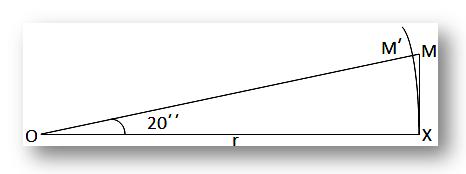Subscribe to our ▶️ YouTube channel 🔴 for the latest videos, updates, and tips.
Problems based on S R Theta Formula
Here we will solve two different types of problems based on S R Theta formula. The step-by-step explanation will help us to know how the formula ‘S is Equal to R’ is used to solve these examples.
Problems based on S R Theta Formula:
1. The large hand of a big clock is 35 (thirty-five) cm long. How many cm does its extremity move in 9 (nine) minutes?
Solution:The angle traced by the large hand in 60 minutes = 360°
= 2π Radians.
Therefore, the angle traced by the large hand in 9 minutes
= [(2π/60) × 9] Radians
= 3π/10 Radians
Let s be the length of the arc moved by the tip of the minutes hand, then
s = rθ
or, s = [35 × (3π/10)] cm
or, s = [35 ∙ (3/10) ∙ (22/7)] cm
or, s = 33 cm.
2. Assuming the distance of the sum from the observer to be 9,30,00,000 miles and the angle subtended by the diameter of the sun at the eye of the observer to be 32', find the diameter of the sun.
Solution:
Let O be the observer, C the center of the sun and AB be the diameter of the sun.
Then by problem, OC = 9,30,00000 and ∠AOB = 32' = (32/60) × (π/180) radian.If we draw a circle with center at 0 and radius OC then the arc intercepted by the diameter AB of the sun on the drawn circle will be very nearly equal to the diameter AB and of the sun (since OC is very large ∠AOB is very small).
Therefore, using the formula s = rθ we get,
AB = OC × ∠AOB, [Since, s = AB and r = OC]
= 9,30,00000 × 32/60 × π/180 miles
= 9,30,00000 × 32/60 × 22/7 × 1/180 miles
= 8,67,686 miles (approx.)
Therefore, the required diameter of the sun = 8,67,686 miles (approx.).
3. At what distance does a man, 5½ feet in height, subtend an angle of 20”?
Solution:
Therefore, ∠MOX = 20" = {20/(60 × 60)}° = 20/(60 × 60) = π/180 radian.
Clearly, ∠MOX is very small; hence, MX is very small compared to OX.
Therefore, if we draw a circle with center at O and radius OX, then the difference between arc length M’X and MX will be very small. Hence, we can take, arc M'X = MX = height of the man = 5½ feet = 11/2 feet. Now, using the formula, s = rθ we get,
r = OX
or, r = s/θ
or, r = (Arc M’X)/θ
or, r = MX/θ
or, r = (11/2)/[20/(60 × 60) × (π/180)]
or, r = (11 × 60 × 60 × 180 × 7)/(2 × 20 × 20) feet.
or, r = 10 miles 1300 yards.
Therefore, the required distance = 10 miles 1300 yards.
● Measurement of Angles
- Sign of Angles
- Trigonometric Angles
- Measure of Angles in Trigonometry
- Systems of Measuring Angles
- Important Properties on Circle
- S is Equal to R Theta
- Sexagesimal, Centesimal and Circular Systems
- Convert the Systems of Measuring Angles
- Convert Circular Measure
- Convert into Radian
- Problems Based on Systems of Measuring Angles
- Length of an Arc
- Problems based on S R Theta Formula
From Problems based on S R Theta Formula to HOME PAGE
Didn't find what you were looking for? Or want to know more information about Math Only Math. Use this Google Search to find what you need.



New! Comments
Have your say about what you just read! Leave me a comment in the box below. Ask a Question or Answer a Question.